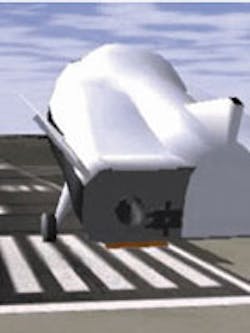The Aerospace Blockset can model vehicle dynamics of a NASA HL-20 lifting body
Aircraft development and UAV (unmanned air vehicles) design and simulation are challenging tasks. Many designers and programmers take advantage of tools like The Mathworks's Matlab and Simulink to handle everything from airfoil design to autonomous and semiautonomous control systems.
One of the neat toolkits that extends Simulink is the Aerospace Blockset. This package addresses a range of modeling and simulation tasks for aircraft, spacecraft, and propulsion systems. It includes blocks for modeling equations of motion, navigation, unit conversion and visualization. It also provides standard references and environmental models including gravity, magnetic fields and wind. There are predefined utilities for operations such as converting units, plus transforming coordinate systems and spatial representations.
UAV design can be address at a variety of levels. It is possible to simulate vehicles and vehicle components such as the propulsion, actuators and control systems. It is possible to model flight dynamics including the use of three- and six-degrees-of-freedom equations of motion with fixed or variable mass objects.
Simulink and the Aerospace Blockset work with other Mathworks tools such as the Real-Time Workshop and the xPC Target that are available separately. The system allows automatic code generation that can be used in production and hardware-in- the-loop systems. It is also very handy for rapid prototyping. Applications work with the FlightGear simulator using the Animation library.
There are a number of libraries included in the package such as the Actuators, Aerodynamics, Flight Parameters and Mass Properties library. The Propulsion library includes examples such as a turbofan engine system block that implements a first-order representation of the engine and the controller. It can compute the thrust and fuel flow at a specific throttle position, Mach number, and altitude. The GNC (guidance, navigation, and control) library uses prebuilt guidance, navigation, and control components. It allows designers to understand and test system behavior.
About the Author
William G. Wong
Senior Content Director - Electronic Design and Microwaves & RF
I am Editor of Electronic Design focusing on embedded, software, and systems. As Senior Content Director, I also manage Microwaves & RF and I work with a great team of editors to provide engineers, programmers, developers and technical managers with interesting and useful articles and videos on a regular basis. Check out our free newsletters to see the latest content.
You can send press releases for new products for possible coverage on the website. I am also interested in receiving contributed articles for publishing on our website. Use our template and send to me along with a signed release form.
Check out my blog, AltEmbedded on Electronic Design, as well as his latest articles on this site that are listed below.
You can visit my social media via these links:
- AltEmbedded on Electronic Design
- Bill Wong on Facebook
- @AltEmbedded on Twitter
- Bill Wong on LinkedIn
I earned a Bachelor of Electrical Engineering at the Georgia Institute of Technology and a Masters in Computer Science from Rutgers University. I still do a bit of programming using everything from C and C++ to Rust and Ada/SPARK. I do a bit of PHP programming for Drupal websites. I have posted a few Drupal modules.
I still get a hand on software and electronic hardware. Some of this can be found on our Kit Close-Up video series. You can also see me on many of our TechXchange Talk videos. I am interested in a range of projects from robotics to artificial intelligence.

